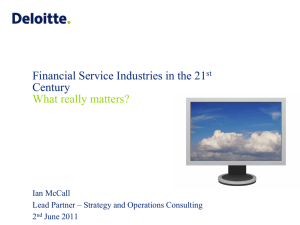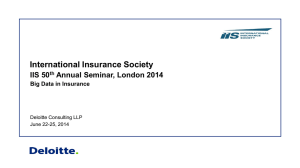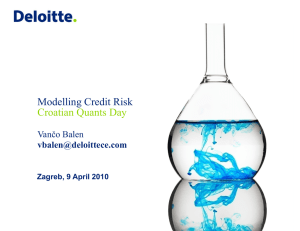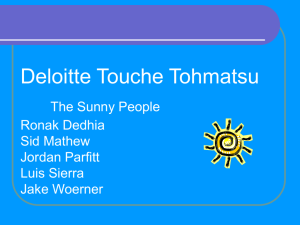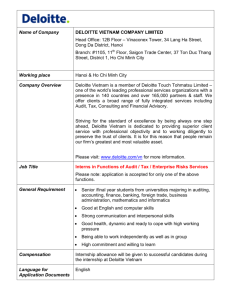ASSOCHAM - National conference on ‘A Scientific Art of Valuation’
advertisement
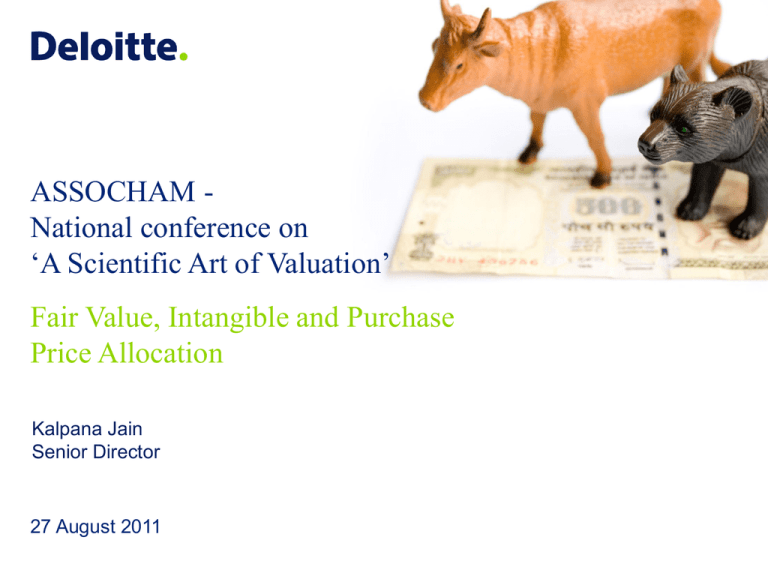
ASSOCHAM National conference on ‘A Scientific Art of Valuation’ Fair Value, Intangible and Purchase Price Allocation Kalpana Jain Senior Director 27 August 2011 Agenda • Purchase price Allocation – An Overview • Valuation for PPA • Key considerations in Intangible Valuation 2 ©2011 Deloitte Touche Tohmatsu India Private Limited Purchase Price Allocation – An Overview ©2011 Deloitte Touche Tohmatsu India Private Limited Introduction Accounting for business combination based on IFRS, US GAAP require allocation of consideration paid to tangible and intangible assets acquired Consideration paid for acquisition Allocated to Tangible assets Intangible assets In proportion to their Fair Market Value Goodwill Such allocation requirement driven by Transparency to stakeholders for consideration paid for business combinations 4 ©2011 Deloitte Touche Tohmatsu India Private Limited Requirement and identification Tangible assets • Net Current Assets • Fixed assets IFRS 3/3R & FAS 141R on Business Combinations Critical attributes of an intangible: Intangible assets • Identify intangible assets based on accounting standard requirements • Identifiability, which includes ‒ Separability (or) ‒ Contractual rights • Measurability • Control • Future economic benefits PPA mostly involve valuation of intangible assets since in many cases tangible assets considered at book value 5 ©2011 Deloitte Touche Tohmatsu India Private Limited Importance of Intangible Assets • • Brands Royalties Revenue Enhancement • • • • Patents Trademarks Create Entry Barriers Intangible Assets generate... Know-How Trade Secrets Cost Savings Competitive Advantages 6 ©2011 Deloitte Touche Tohmatsu India Private Limited Intangible Assets drive Market Value Goodwill Intangible Assets Appreciation in Tangible Assets Market Value Fair Value of Tangible Assets Categories • Marketing Based • Customer Related • Artistic Related • Contract Based • Technology Based Book Value VALUE OF A FIRM XYZ 7 ©2011 Deloitte Touche Tohmatsu India Private Limited What are implications? Acquired Intangible Assets Internally Generated Assets Not Recognised 8 Goodwill Arising from Contractual or Legal Rights Finite Lives Indefinite Lives Not Amortised Amortised Not Amortised Impairment Test Impairment Test Impairment Test ©2011 Deloitte Touche Tohmatsu India Private Limited Purchase Price Allocation – Process STEP 1 Business / Enterprise Valuation to estimate IRR / WACC 9 STEP 2 STEP 3 Identification of Intangible Assets Valuation of Tangibles and Intangibles STEP 4 STEP 5 Allocating Value Reconciliation of Results ©2011 Deloitte Touche Tohmatsu India Private Limited Categories of Intangible Assets Intangible assets that relate to customer structure or customer relationships of the business Customer Related • Customer relationships • Order or production backlog • Customer list Technology-based intangible assets relate to innovations or technological advances • Patents Technology Based • Software • Know-how • Developer technology Intangible assets that have a fixed or definite term which is agreed upon by both parties and written in the contract Contractual rights to receive money or contractual obligations to pay money on fixed or determinable dates Contract Based • Licensing, royalty, standstill agreements • Advertising, construction, management, service or supply contracts • Lease agreements • Construction permits • Franchise agreements 10 ©2011 Deloitte Touche Tohmatsu India Private Limited Categories of Intangible Assets Marketing-related intangible assets are those assets that are primarily used in the marketing or promotion of products or services Marketing Related • Trademarks • Brands • Internet domain names • Non-compete agreement Artistic-related intangible assets meet the criteria for recognition apart from goodwill if the assets arise from contractual rights or legal rights such as those provided by copyright • Plays, operas, ballets Artistic Related • Books, magazines, newspapers, other literary works • Musical works such as compositions, song lyrics, advertising jingles • Pictures, photographs • Video and audiovisual material, including motion pictures, music videos, television programs 11 ©2011 Deloitte Touche Tohmatsu India Private Limited Valuation for PPA ©2011 Deloitte Touche Tohmatsu India Private Limited What is Fair Value? Appendix A of IFRS 3 Appendix F - Glossary of FAS 141 The amount for which The amount at which • an asset could be exchanged or a liability settled, • an asset (or liability) could be bought (or incurred) • in a current transaction • in a current transaction • between knowledgeable, willing parties, • between willing parties, • in an arm’s length transaction • that is, other than in a forced or liquidation sale Appendix A of IFRS 13 The price that would be received • To sell an asset or paid to transfer a liability, • in an orderly transaction • between market participants, • At the measurement date 13 ©2011 Deloitte Touche Tohmatsu India Private Limited Approaches to estimate Fair Value Income / Economic Value Approach Cost Approach Based on the present value of expected future earnings / cash flows to be derived from ownership of the asset Based on the cost to reproduce or replace the asset • Excess Earnings • Relief from Royalty • Discounted Cash Flow • Comparative Business Valuation • Historical Cost • Replacement Cost Fair Value Market Approach Based on transactions involving the sale or license of similar assets in the marketplace 14 ©2011 Deloitte Touche Tohmatsu India Private Limited Key Considerations in Intangible Valuation ©2011 Deloitte Touche Tohmatsu India Private Limited WACC for Intangible Assets • Required rates of return attempt to estimate the return a typical investor would require ‒ Dependant on perceived risk, liquidity • The weighted average cost of capital or “WACC” is the required return on a business entity’s invested capital • The component assets of a business require different returns ‒ Disparate returns reflect differences in perceived risk and liquidity ‒ Intangible assets are often considered the highest risk assets of a business enterprise due to: ‒ Lack of versatility ‒ Illiquidity ‒ Susceptibility to competitive forces ‒ Goodwill generally has the highest required rate of return ‒ Usually appears last in the development of a business ‒ Disappears first in a business demise 16 ©2011 Deloitte Touche Tohmatsu India Private Limited WACC for Intangible Assets • In these instances, the required return for Intangibles can be estimated as a premium to the WACC or the cost of equity of the company Low ROCE > CoC Intangible Liquidity Fixed Asset Higher than WACC WACC Debtors Lower than WACC Cash High Low 17 Risk High Required Return ©2011 Deloitte Touche Tohmatsu India Private Limited Remaining Useful Life (RUL) • Definition ‒ The period over which an asset is expected to contribute to future cash flows • Determine RUL based on an analysis of: ‒ The expected use of the asset by the target ‒ Should not consider buyer’s intent (i.e. abandonment) ‒ The expected useful life of another asset or a group of assets to which the useful life of the intangible asset may relate ‒ Legal, regulatory, or contractual provisions that may limit the useful life or enable renewal or extension of the asset’s legal or contractual life without substantial cost ‒ Effects of physical deterioration, functional obsolescence, technological obsolescence, and economic obsolescence ‒ Estimation of the future benefit derived from the intangible asset 18 ©2011 Deloitte Touche Tohmatsu India Private Limited Remaining Useful Life (RUL) ‒ Level of maintenance expenditures required to obtain the expected future cash flows from the asset ‒ Level of capital investment required to maintain ‒ Asset’s position in industry or product lifecycle ‒ Competitive forces ‒ Market conditions ‒ Changing consumer preference or asset use ‒ Rate of technological change ‒ Renewal patterns ‒ Historical pattern 19 ©2011 Deloitte Touche Tohmatsu India Private Limited Tax Amortization Benefit (TAB) • Identified intangibles are typically amortizable for tax purposes: ‒ If acquired in isolation, Indian tax laws allows companies to amortize only certain Intangible assets such as: Know-how, patents, copyrights, trademarks, Licenses, Franchises, or any other business or commercial rights of similar nature ‒ Must consider local tax regulations • Amortization usually results in a tax-deductible expense (depending on country) • Amortization reduces taxable income and the resulting tax savings should be included in the fair value of the asset when performing an income approach and cost approach valuation • “Circular” – ‒ Need fair value of asset to estimate TAB ‒ but need TAB to estimate fair value of asset ‒ Can avoid circular references by using a tax amortization benefit factor calculation 20 ©2011 Deloitte Touche Tohmatsu India Private Limited Contact Kalpana Jain Senior Director Tel: +91 (0) 124 679 2266 Email : kajain@deloitte.com Deloitte Touche Tohmatsu India Private Limited Building 10, Tower B, 7th Floor, DLF Cyber City, Gurgaon 122 022 Tel : +91 (0124) 679 2000 Fax : + 91 (0124) 679 2012 21 ©2011 Deloitte Touche Tohmatsu India Private Limited Deloitte refers to one or more of Deloitte Touche Tohmatsu Limited, a UK private company limited by guarantee, and its network of member firms, each of which is a legally separate and independent entity. Please see www.deloitte.com/about for a detailed description of the legal structure of Deloitte Touche Tohmatsu Limited and its member firms. This material and the information contained herein prepared by Deloitte Touche Tohmatsu India Private Limited (DTTIPL) is intended to provide general information on a particular subject or subjects and is not an exhaustive treatment of such subject(s). None of DTTIPL, Deloitte Touche Tohmatsu Limited, its member firms, or their related entities (collectively, the “Deloitte Network”) is, by means of this material, rendering professional advice or services. The information is not intended to be relied upon as the sole basis for any decision which may affect you or your business. Before making any decision or taking any action that might affect your personal finances or business, you should consult a qualified professional adviser. No entity in the Deloitte Network shall be responsible for any loss whatsoever sustained by any person who relies on this material. ©2011 Deloitte Touche Tohmatsu India Private Limited


